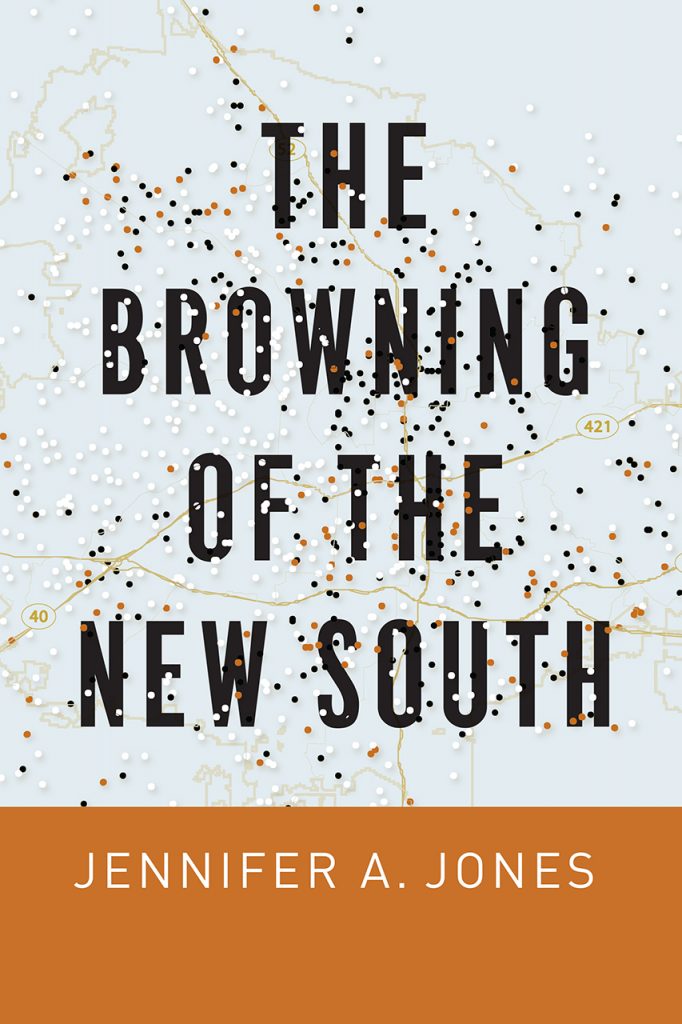Five Question for Jennifer A. Jones, author of “The Browning of the New South”
Studies of immigration to the United States have traditionally focused on a few key states and urban centers, but recent shifts in nonwhite settlement mean that these studies no longer paint the whole picture. Many Latino newcomers are flocking to places like the Southeast, where typically few such immigrants have settled, resulting in rapidly redrawn communities. In this historic moment, Jennifer A. Jones brings forth an ethnographic look at changing racial identities in one Southern city: Winston-Salem, North Carolina.
To get a better sense of what inspired Jones to focus her book on this particular city, we sent her a few questions recently about her research.
How did you come to follow the line of research that forms the backbone of The Browning of the New South?
In some ways, I came to the research that forms the backbone of The Browning of the New South by accident. I consider myself a race scholar, and for my MA research I had done some ethnographic research on group identity formation among multiracials. I was really interested in how race gets made and wanted to pursue another project that helped me explore that process. I came to Winston-Salem to do research because I thought it fit my criteria for exploring how racial lines get drawn. I think of immigration as a fundamental racial question—how immigrants get integrated, how communities perceive them, and what policies regulate their arrival and settlement are often questions of race. I knew that there was a significant minority of Afro-descendant Mexicans who lived in Winston, and I thought that this would make for a perfect experiment: how would new Mexican immigrants of various phenotypes come to understand race in a historically black/white context? What I didn’t know was that our approaches to immigration policy were changing rapidly at the local level and that this would be more important than phenotype in shaping race relations and immigrant integration in the region.
What most surprised you in your research or writing of the book?
There were a lot of surprises along the way, but the most important one was around the importance of immigration politics. When I entered the field, immigration was in the news. The immigrant marches had recently happened to protest the Sensenbrenner bill, and there was a lot of talk nationally about what do to about immigration reform. But coming from California, I had no idea how much states were getting involved in immigration politics. North Carolina was on the front lines of attempting to address immigration at the state and local level and it was a core issue in the election cycle for 2008. Candidates were campaigning on whether or not immigrants should be welcome in their communities, sheriffs were deciding whether or not to partner with Immigration and Customs Enforcement to deport people, local ordinances were being passed to regulate whether immigrants could access social services, and the state was debating how much it would restrict access to higher education and driver’s licenses. Latin American immigrants, mostly Mexican, had been arriving in the state in large numbers since the 1990s. From their perspective, suddenly, many of their neighbors and representatives wanted them gone. The other side of this was that most of this talk of expulsion and painting immigrants as criminals was coming from white residents. While many white residents expressed tolerance or support, many more engaged in the kind of explicit hostility that seems common today. Their black neighbors, however, overwhelmingly took a different approach. They condemned efforts to criminalize immigrants, were suspicious of policies that aimed to take away access to social services, and remained largely welcoming to their Latino neighbors, who frequently settled alongside them in historically black communities. It was these two experiences—not skin color per se—that mattered most in shaping racial meanings and race relations in Winston.
How you do you foresee some of the topics of your book—particularly Latin American immigration and changing demographics in a potential swing state like North Carolina—playing into the 2020 elections?
I think changing demographics and immigration are always important political issues in the United States. In the 2020 election, however, I think these issues are going to play a really important role on both sides. I expect that the Trump administration and many Republicans up for municipal and state election will continue to double down on a kind of new Southern Strategy that demonizes immigrants, particularly those from Latin America, but also from Africa and the Caribbean. The kinds of strategies being used on the national stage were first pioneered in places like North Carolina. It is an effective, if cynical strategy.
However, I also see more possibilities for resistance. The unintended consequence of this strategy, as I show in my book, is that it instigates a sense of linked fate among racial minorities and other marginalized groups and helps them to build new coalitions that not only fight back against these attacks, but offer alternative progressive policy agendas. I think we saw this in the candidacy of Stacey Abrams, and that these coalitions will matter even more in 2020. In North Carolina specifically, there is a serious battle happening between these competing agendas. Numerous coalitions, such as Reverend William Barber’s work to build a Poor People’s Campaign, have done essential work to push North Carolina toward its purple status, capitalizing on demographic change in the state, in part, to make that possible. At the same time, voter suppression has been rampant and ugly in the state, designed to tamp down the very voters that are at the core of these new progressive coalitions. Demographic change is absolutely at the core of this—not just immigrants, although they have almost certainly been pushed to the left, but also upwardly mobile African-Americans and progressive whites who are increasingly settling in the state. In that sense, while 2020 is certainly up for grabs, Republicans ultimately have a strategy that may win elections in the short term but will also likely galvanize multiracial coalitions in the long term. It may take another election cycle or two, however, to see those effects.
Where do you anticipate your research taking you next?
I’m very much interested in the relationship between race and immigration politics and am now working a project with my colleague Hana Brown at Wake Forest that looks at the relationship between racial ideologies, immigrant serving organizations, and political outcomes in four Southern states: Mississippi, Alabama, North Carolina, and Georgia. While this project is still very much in progress, we are finding that how organizations think about race shapes not only the organization itself, but the kinds of outcomes it produces. Our favorite example of this is the Mississippi Immigration Rights Alliance (MIRA), a multiracial coalition of activists and advocates that not only talk about immigration as a race issue, but work closely with the state’s black caucus on its legislative agenda. As a result, compared to a state like Alabama, Mississippi has not only passed very punitive laws, but also has had numerous municipal victories for progressives in the state, such as declaring Jackson a sanctuary city, electing progressive activist Chokwe Lumumba as mayor, and shaping the discourse on immigration in the state to directly link it to histories of racialized exclusion and a broad civil rights agenda.
What is the best book you’ve read recently?
There are two books lately that have really challenged my thinking in the best way possible. The first is Beneath the Surface of White Supremacy: Denaturalizing US Racisms Past and Present, by Moon-Kie Jung, and In the Wake: On Blackness and Being, by Christina Sharpe. Both books helped me think differently about race and society. They also inspired me to think differently as a writer—each brings so much of themselves to the text in tone and feeling. As scholars, we are not taught to write in a way that centers the person as well as the scholarship, and both Sharpe and Jung do this beautifully in their own way.
The Browning of the New South is available now! Find it on our website, online at any major booksellers, or at your local bookstore.

Jennifer A. Jones is assistant professor of sociology at University of Illinois at Chicago.
